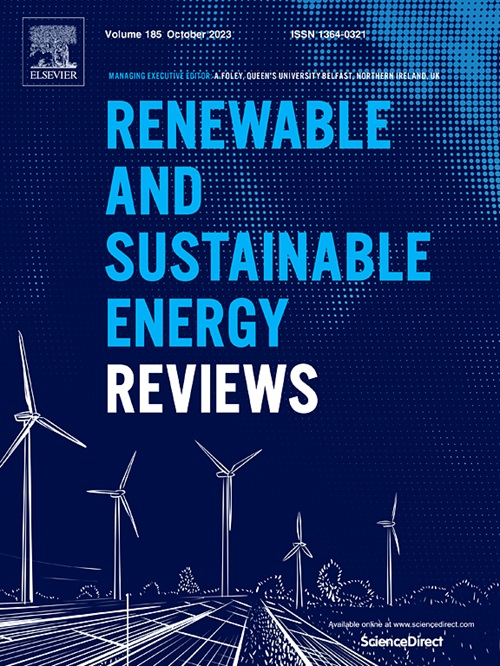Quantifying land-energy interactions of hydropower in the Western United States
IF 16.3
1区 工程技术
Q1 ENERGY & FUELS
引用次数: 0
Abstract
Estimates for the land use of electricity generation technologies rely on limited information, challenging the representativeness of assumptions in energy systems analyses that use tools like life cycle assessment and grid optimization. This study used facility-level geospatial image analysis to quantify the land directly impacted for over 500 hydroelectric power plants in the U.S. Western Interconnection to create a database of the land requirements of hydropower projects, classifying power plants by mode of operation. The area of the plant, reservoir, and conveyance channels was delineated using aerial imagery to determine land-use efficiency (W/m2) and land transformation (m2/MWh). Run-of-river facilities without reservoirs have higher land-use efficiencies than storage facilities with reservoirs, with a median operational land-use efficiency of 150 W/m2 (range 1.3–13,000 W/m2) compared to storage projects with a median of 1.4 W/m2 (0.010 W/m2 – 98 W/m2). Run-of-river projects’ median annual land transformation is 0.78 m2/MWh (0.0090–88 m2/MWh), two orders of magnitude lower than the median for storage projects, 84 m2/MWh (1.2–11,000 m2/MWh). Reservoirs are documented for 45 % of the run-of-river plants, resulting in median annual land transformation of 15 m2/MWh (0.028–6700 m2/MWh), one fifth of the median for storage projects. Results confirm the importance of using land sparing opportunities for new projects, such as upgrading hydropower plants and converting non-power dams to reduce or eliminate additional land requirements. The resulting inventory has broad applicability in future research focused on life cycle assessment, energy transitions, power systems planning, and the evaluation of ecological impacts of hydropower.

量化美国西部水电的陆能相互作用
发电技术的土地利用估算依赖于有限的信息,这对使用生命周期评估和电网优化等工具进行能源系统分析的假设的代表性提出了挑战。本研究采用设施级地理空间图像分析方法,对美国西部电网500多个水电站直接影响的土地进行量化,建立水电项目用地需求数据库,并按运行方式对电厂进行分类。利用航空图像划定了植物、水库和运输渠道的面积,以确定土地利用效率(W/m2)和土地改造(m2/MWh)。无水库的径流设施的土地利用效率高于有水库的水库设施,其运行土地利用效率中位数为150 W/m2(范围为1.3 - 13000 W/m2),而水库项目的运行土地利用效率中位数为1.4 W/m2(范围为0.010 W/m2 - 98 W/m2)。顺流项目的年土地流转中值为0.78 m2/MWh (0.0090 ~ 88 m2/MWh),比蓄能项目的年土地流转中值84 m2/MWh (1.2 ~ 11000 m2/MWh)低两个数量级。45%的顺流电厂都有水库的记录,每年的土地转化中值为15平方米/兆瓦时(0.028-6700平方米/兆瓦时),是水库项目中值的五分之一。结果证实了利用土地节约机会进行新项目的重要性,例如升级水电站和改造非电力大坝,以减少或消除额外的土地需求。该清单在未来的生命周期评估、能源转换、电力系统规划和水电生态影响评价等研究中具有广泛的适用性。
本文章由计算机程序翻译,如有差异,请以英文原文为准。
求助全文
约1分钟内获得全文
求助全文
来源期刊

Renewable and Sustainable Energy Reviews
工程技术-能源与燃料
CiteScore
31.20
自引率
5.70%
发文量
1055
审稿时长
62 days
期刊介绍:
The mission of Renewable and Sustainable Energy Reviews is to disseminate the most compelling and pertinent critical insights in renewable and sustainable energy, fostering collaboration among the research community, private sector, and policy and decision makers. The journal aims to exchange challenges, solutions, innovative concepts, and technologies, contributing to sustainable development, the transition to a low-carbon future, and the attainment of emissions targets outlined by the United Nations Framework Convention on Climate Change.
Renewable and Sustainable Energy Reviews publishes a diverse range of content, including review papers, original research, case studies, and analyses of new technologies, all featuring a substantial review component such as critique, comparison, or analysis. Introducing a distinctive paper type, Expert Insights, the journal presents commissioned mini-reviews authored by field leaders, addressing topics of significant interest. Case studies undergo consideration only if they showcase the work's applicability to other regions or contribute valuable insights to the broader field of renewable and sustainable energy. Notably, a bibliographic or literature review lacking critical analysis is deemed unsuitable for publication.
 求助内容:
求助内容: 应助结果提醒方式:
应助结果提醒方式:


